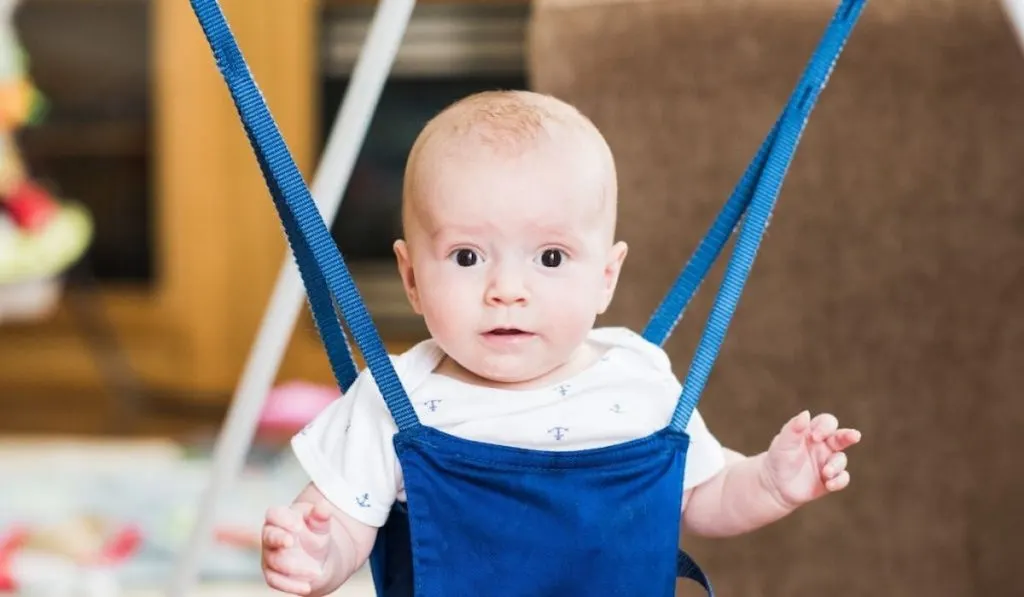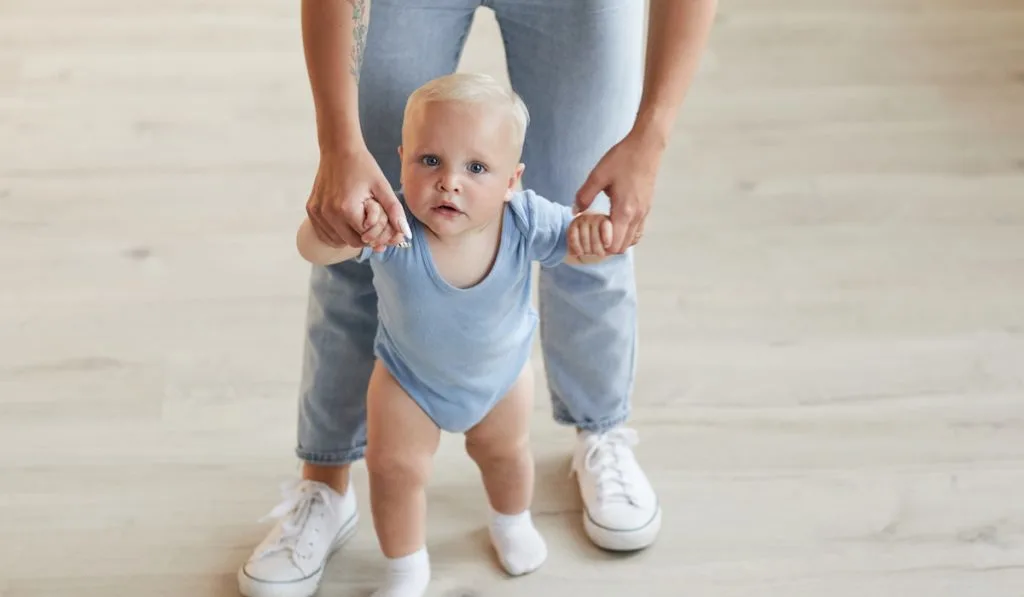For a while now, jolly jumpers have been a controversial topic. Many have put them under scrutiny, raising several discussions and arguments that either oppose or defend their adoption at home as toys for babies.
To help the parents make better and informed decisions before purchasing, this article elaborates about jolly jumpers, their pros and cons, and how best you can use the jumpers with consideration for your baby’s health.

What is a Jolly Jumper?
A jolly jumper is a bouncing toy that allows babies to bounce from the floor with their feet.
It can be a lot of fun watching your baby play with lots of giggles, and it can give you a small breathing space to keep your child busy for a while.
Are Jolly Jumpers Safe?
Generally, jolly jumpers are not safe. However, depending on the baby’s age, jumpers can be acceptable to play with, but only for a limited period.
The toy has been praised by many parents as a God-send because it gives them the much-needed hands-free time to sort out other issues at home. It is further praised for aiding the baby’s development in a way, but criticized for potentially harming the baby’s growth and development.
Prolonged use of jumpers can cause serious issues with the baby’s nervous system and skeletal growth.
However, depending on the infant’s age, it is the duty of every parent to research and be informed beforehand of the best products for their babies to give them the safest, healthiest, and most fun playtime possible.

Types of Jolly Jumpers
Jolly jumpers are available in three types, namely;
- The first type features a soft-sling-shaped seat attached to a door and one big spring that gives room for swinging.
- Secondly, steady jumpers are a type of stationary jumpers featuring a suspended seat hanging from either two or four fabric-covered springs.
- Lastly, stationary jumpers are those that have baby seats sitting on springs instead of being suspended.
Although the last two are safer for the baby, none are better, since they all pose a developmental risk for the baby.
However, when buying a jumper for your baby, you should consider the manufacturer’s recommendations. Different bouncers are designed for kids with certain age brackets. As a responsible parent, you should never leave your child in the jumper unattended, and stop using the toy as soon as the baby sits up without any assistance.
Further care should be taken when installing the jumpers. They should be in proper shape, not damaged, and should be placed on even surfaces.
Risks of Using Jolly Jumpers
Jolly jumpers are greatly discouraged by many baby-health experts because when they are used for extended periods, they pose growth and developmental risks to your toddler.
These include neural and even skeletal growth disruption.
Development Risks

Although jolly jumpers are fun, they promote body movements that are detrimental to the motion skill the baby needs to be developing. For babies to sit up, crawl, and walk, they need to gradually develop their strength, balance, coordination, and spatial awareness, among other important factors.
With jumpers, babies are not in control of their body movements and are only excited because of the bounce. This means that the more time the baby “exercises” on jolly jumpers, the less attention is given to the essential growth and development muscles like in tummy time.
Furthermore, the babies are not always mature enough to support their body weight and control their body movements, especially when bouncing fast. As they bounce, the baby’s weight is supported by the hips, underarms, and crotch, consequently pushing the baby forward instead of upright.
If they get used to this kind of jumping, they may develop problems with maintaining proper posture, leg and trunk control. Furthermore, babies may get used to pointing their toes due to habitual jumping and inappropriate leg posture which leads to a shortened Achilles tendon and a decreased glute muscle.
This, with the posture complications, can lead to a delay in the development of walking skills, or even worse, foot deformities.
Safety Risks
For a fact, jolly jumpers are toys and are subject to mechanical failure which can badly hurt your baby, including head injuries. Babies might also get their little fingers trapped between the springs of a jumper.
Frame-mounted jumpers are specifically dangerous because they might slip off the frame, or the baby might slip out if not well-strapped.
Other Risks of Using Jolly Jumpers
Jolly jumpers can also lead to muscle imbalance because the jumpers subject them to maintain an upright position long before their muscles and backbones are ready to hold the posture.
Hip dysplasia is another probable risk because of the hip posture that the jumpers need the baby to maintain.
Advantages of Using Jolly Jumpers
Although jolly jumpers are generally not good for your child, they are beneficial to some extent, as long as you get the appropriate jumper for your baby. So, what are these advantages?
- Babies develop improved muscles because of jumping. With the gradual improvement of strength, babies will develop pre-walking abilities which can be nice.
- When equipped with a comfortable seat and a set of appealing toys, jumpers effectively take the baby’s attention, giving parents some free time.
- When babies are tired, they can also help them to sleep.

Better Alternatives
It is better to put the baby on the floor, lying on their tummy, than putting them in jolly jumpers. Tummy time is specifically necessary for developing healthy and strong leg and trunk muscles.
Instead of jumpers that limit and control the baby’s body and muscle movements, leaving them lying on the floor and letting them find their way around and learning how to control their movements on their own, rolling, crawling, or sitting up, is the best exercise they could have.
Baby walkers are also a better alternative because they don’t have to be bouncy. However, you should always keep an eye on the baby and ensure that the potentially dangerous areas in the house are blocked off.
When Can Your Baby Start Jumping?
With jolly jumpers, there is no tested rule that is applicable on when babies should start using one. However, different babies grow at different rates, they should be good to go as soon as they can steadily and independently hold their heads in an upright position.
Most jolly jumpers have a weight limit, mostly 25 to 30 pounds, this is mostly when your baby can walk. You can safely use jumpers till any of the above happens, or when the baby constantly wants to pull themselves out through the sides or want to roll over.
As soon as this happens, you should stop using the jumpers.
Jolly jumping is only recommended for about 10 – 15 minutes at a time, and should not be repeated more than twice a day. However, most parents and guardians might be tempted to leave the baby bouncing in a jumper while they execute some chores.

If left unattended for long, there is a risk that the baby might get uncomfortable or even hurt themselves. You should never leave them in jumpers unattended.
Other Tips for Using Baby Jumpers
- Always keep the floor around jumpers clean to enable the baby to jump in a conducive and comfortable space.
- Avoid playing around potentially harmful areas like around pools and stairways
- Always ensure that the baby is firmly strapped to the jumper to avoid accidentally toppling off. Further, ensure that both the baby and the jumper are secure to avoid bumping into walls.
- Avoid as much as possible connecting toys to the jumper strings.
- Cover the exposed strings on the jumpers to avoid finger injuries.
- Install the jumpers at the proper height regarding the baby’s size and weight.
Conclusion
Provided that you are careful and mindful of your baby’s health concerning good growth and development, there is no reason to avoid installing jolly jumpers if they can help you get some hands-free time.
Provided that you get the most appropriate jolly jumper for your child, both you and the baby should enjoy the playtime.
However, always keep in mind that the best way to exercise the baby’s muscles and challenge them to develop is by letting the child figure things out on their own, most preferably through tummy time. Simply place the child on the ground lying on their belly and let them explore.
Resources
- https://www.abc.net.au/news/2018-10-22/sa-health-recommends-not-using-baby-walkers-or-jolly-jumpers
- https://www.myfootdr.com.au/2020/03/jolly-jumpers-walkers-should-your-child-be-using-them
- https://www.healthline.com/health/baby/baby-jumper-age#benefits
- https://momtalknb.com/jolly-jumpers-really-safe-dr-marie-battaglia
- https://babieslab.com/baby-jumper-good-or-bad
- https://www.webmd.com/baby/when-can-a-baby-use-a-jumper-toy
- https://www.hellomotherhood.com/article/286964-development-infant-jumpers
